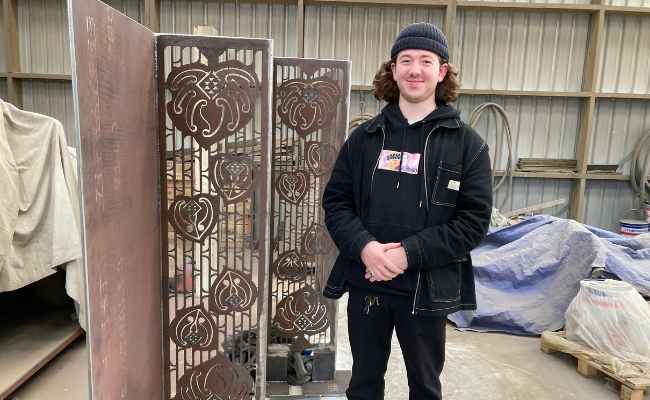Monday 8 August 2022 2:44pm

Sculptor Aidan Geraghty (Kāi Tahu, Kati Māmoe, Ngāi Tūāhuriri) draws on contemporary art theory for his work on Hei Maumaharatanga Memorial Wall to be installed on campus.
Work is underway on a small Dunedin campus construction project with cultural significance beyond its size.
When built, the Hei Maumaharatanga Memorial Wall, near the banks of the Leith between Leith Walk and the Clyde Street bridge, will offer a quiet space in which to commemorate past students and staff, groups, and events associated with the University of Otago.
The nearly 4m-long stepped wall of steel panels will bear brass plaques and end in a 2m-high bluestone pillar emblazoned with the University logo.
Art laser-cut as fretwork into the steel joining the three main panels of the wall is designed to speak to the memory of tīpuna shared by iwi and Pacific Peoples and create pause for contemplation and healing for all.
Sculptor Aidan Geraghty (Kāi Tahu, Kati Māmoe, Ngāi Tūāhuriri) is excited to see his vision being fabricated and savouring the sense of grandeur in the project and process as his design is laser-cut into steel at Precision Profile.
It’s being assembled by Arc Fabrication and Diesel and powdercoated by Blasting and Coating Services, so the finished fretwork is the result of shared mahi.
Mr Geraghty got involved when the University’s Strategic Architect Gordon Roy approached then Kaitohu Matāuraka of the Office of Māori Development, Megan Pōtiki, for cultural input on the wall.
With Mr Geraghty’s fellow artist Simon Kaan of Dunedin consultancy Aukaha, the trio got together to begin an inspired kōrero for Hei Maumaharatanga to express and build upon the commemorative traditions of te ao Māori.
As a result of their shared knowledge, observers of the wall will see the shape of kawakawa leaves in it.
Their tips are stylised in the shape of Aorāki in homage to the motifs carved in tukutuku paneling on many contemporary South Island marae.
Both the kawakawa plant and the revered māunga (mountain) contain potent symbolism, Mr Geraghty says.
“Kawakawa has healing properties and belongs to Rongo.”
“Kawakawa is used as a traditional Māori rongoā (remedy), symbolic of its healing properties. It belongs to Rongo-mā-Tāne as the atua (god) of agriculture,” he says.
The Otago Polytechnic Bachelor of Fine Arts student began the design work for Hei Maumaharatanga partway through his studies and draws on art theory by Paul Tapsell.
Mr Geraghty says it makes use of taonga by young urbanised Māori “to celebrate and channel the energy of their tīpuna”.
